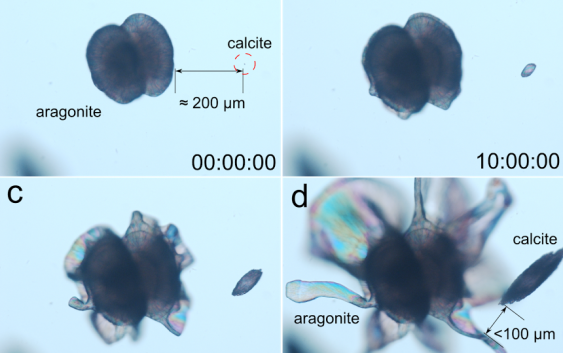The micrographs are extracted from images sequence of a time-lapse video of the simultaneous growth of biomorphic aragonite in elongated calcite in alkaline silica gel. The video was recorded by an optical microscope (Nikon AZ100) with Nikon AZ-Plan Apo 4x objective lens and Nikon digital sight DS-Fi1 camera. The images were captured at constant time intervals (30 minutes) by using NIS-Elements BR, and acquired images sequences were converted to video by ImageJ.
The crystallization of calcium carbonate was performed in a lab made cassette by counterdiffusion method. The cassette provided a defined space with 100 mm in length, 40 mm in width and 1mm of the thickness. The silica sol precursor (1.39 g sodium silicate, Sigma-Aldrich, Ref. 338443, 9 mL 0.2 M Na2CO3) was acidized by 3.5 mL hydrochloric acid (1 M), and then 2 mL of the silica sol was injected into the cassette till half of the volume. The gelling process took a week in this closed cassette, and the final pH of the silica gel was 10.5 ± 0.1. Calcium chloride solution (0.2 M) was injected into the gel-free inner space in the cassette to start the counterdiffusion process, This injection was considered as the zero time of crystallization time scale. The time-lapse video was recorded at the second week of the crystallization, in silica gel in the zone between 1 cm and 2.5 cm vertically from the gel-liquid interface. The video shows the concomitant growth of calcite and aragonite, two different polymorphs of calcium carbonate. It is worth to note the short distance between both crystals. During this growth process, these two crystal phases exhibit a dramatic difference in morphology. The calcite crystal with trigonal structure starts to grow with rhombohedral structure and developed to an elongated fibrous shape, which preserves the crystallographic continuity and symmetry. Unlike this, the orthorhombic aragonite crystal broke the crystallographic symmetry of the starting pseudohexagonal prism and displayed a flower-like biomimetic shape. This video is one of the most dramatic one obtained in our lab and is a perfect example of what biomorphic behavior means.
More information in the paper published in Journal of Material Chemistry B


